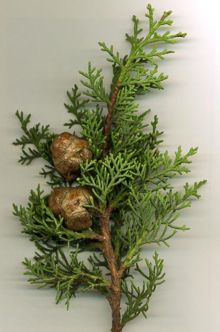
Cupressus sempervirens

Cupressus sempervirens, the Mediterranean cypress (also known as Italian cypress, Tuscan cypress, Persian cypress, or pencil pine), is a species of cypress native to the eastern Mediterranean region, in northeast Libya, southern Albania, coastal Bulgaria, southern coastal Croatia, southern Montenegro, southern Bosnia and Herzegovina, southern Greece, southern Turkey, Cyprus, northern Egypt, western Syria, Lebanon, Malta, Italy, Israel, western Jordan, and also a disjunct population in Iran. Cupressus sempervirens is a medium-sized coniferous evergreen tree to 35 m (115 ft) tall, with a conic crown with level branches and variably loosely hanging branchlets. It is very long-lived, with some trees reported to be over 1,000 years old. The foliage grows in dense sprays, dark green in colour. The leaves are scale-like, 2–5 mm long, and produced on rounded (not flattened) shoots. The seed cones are ovoid or oblong, 25–40 mm long, with 10-14 scales, green at first, maturing brown about 20–24 months after pollination. The male cones are 3–5 mm long, and release pollen in late winter. It is moderately susceptible to cypress canker, caused by the fungus Seiridium cardinale, and can suffer extensive dieback where this disease is common. The species name sempervirens comes from the Latin for 'evergreen'. Mediterranean cypress has been widely cultivated as an ornamental tree for millennia away from its native range, mainly throughout the whole Mediterranean region, and in other areas with similar hot, dry summers and mild, rainy winters, including California, southwest South Africa and southern Australia. It can also be grown successfully in areas with cooler, moister summers, such as the British Isles, New Zealand and the Pacific Northwest (coastal Oregon, Washington and British Columbia). It is also planted in Florida and parts of the coastal southern United States as an ornamental tree. In some areas, particularly the United States, it is known as 'Italian' or 'Tuscan cypress'. The vast majority of the trees in cultivation are selected cultivars with a fastigiate crown, with erect branches forming a narrow to very narrow crown often less than a tenth as wide as the tree is tall. The dark green 'exclamation mark' shape of these trees is a highly characteristic signature of Mediterranean town and village landscapes. Formerly, the species was sometimes separated into two varieties, the wild C. sempervirens var. sempervirens (syn. var. horizontalis), and the fastigiate C. s. var. pyramidalis (syn. var. fastigiata, var. stricta), but the latter is now only distinguished as a Cultivar Group, with no botanical significance. It is also known for its very durable, scented wood, used most famously for the doors of St. Peter's Basilica in the Vatican City, Rome. Cypress used to be used in distilleries as staves to hold mash ferments to make alcohol before the invention of stainless steel. Commonly seen throughout New Mexico, the Mediterranean cypress is also known as the 'drama tree' because of its tendency to bend with even the slightest of breezes. In cosmetics it is used as astringent, firming, anti-seborrheic, anti-dandruff, anti-aging and as fragrance. It is also the traditional wood used for Italian harpsichords. Cypress, Cupressus sempervirens, was the first choice for Iranian Gardens. In all of the famous Persian Gardens, such as Fin Garden, Shazdeh Garden, Dowlat-Abad, and others, this tree plays a central role in their design. The oldest living Cypress is the Sarv-e-Abarkooh in Iran's Yazd Province. Its age is estimated to be approximately 4,000 years.
